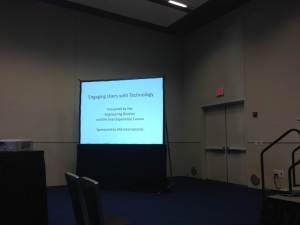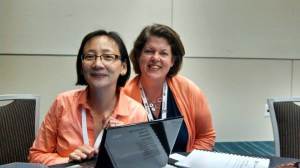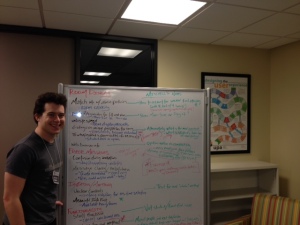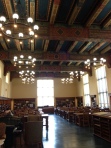I am fresh back from SLA 2012, Chicago, and while I have a lot of UX stuff to talk about, I am going to start with what I did first. On Monday, I was a part of a panel, Web-scale Discovery Implementation with the End User in Mind, with Rafal Kasprowski, Rice University; Debra Kolah, Rice University; Harry Kaplanian, EBSCO Publishing.
Harry provided an introductory historic overview of discovery, from the on-the-fly federated searching and accompanying catalog layers to the single index web-scale discovery, including some humor about the evolution of the card catalog. I talked about the method of choosing a tool, including a comparison grid, a ethnography study and the talented Rafal spoke about OpenURL vs proprietary linking, data and holdings migrations from ILS and resolver knowledge base, and product settings.
We had a lot of questions after the session–there is still great interest out in libraryland about discovery layers, and about half in the room of approximately 60 were actively thinking about purchasing a discovery layer in the near future.
The ethnography study I did for our discovery layer decision is unpublished, but I had read some of the following about some of the informants. (Note: the OneSearch referred to here is our previous discovery layer, Aquabrowser.)
Our informants fell into five major categories:
1)Three informants said they had never heard of OneSearch.
2)Five informants don’t use OneSearch, and do not understand what it searches. One informant stated, “I really don’t know what it covers, presumably it’s one place where you can search for everything, but if I’m looking for articles I go elsewhere, but if I’m looking for general information or books I would use OneSearch.”
3)Three informants have tried OneSearch but either want more control over the search, did not like something about the interface, or experienced failed searches when looking for known items. One informant simply stated, “It doesn’t seem to give me the answers that I want…I feel like I can’t control it to get the things I want.” Another informant stated, “I have used it only a couple of times, both of the times it was pretty useful…but it would be nice to pick which databases I would like to search.”
4) Only one informant uses OneSearch regularly and finds it to be useful. She uses it only with students, not for personal research, especially to search for items that she knows are not covered by the databases with which she is familiar. Emphasizing the wide net that discovery casts is useful to the undergraduate program.
5) One informant does not use OneSearch, but has created his own discovery-like tool using a Mac-based bibliographic program called Papers. The interface has allowed him, with assistance from Rafal and Debra , to identify frequently used Fondren resources, including Scopus, acquire special “keys’ for access, and then search these directly from this third-party interface, where is is identified as a Rice researcher. This user workaround will be interesting to monitor in the coming year, as some of the bibliographic tools, such as Papers and Mendeley, increase their ability for searching within the tool.
Our slideshow will be available soon on SlideShare. Additionally, here is the bibliography that informed my part of the talk:
Fagan, Jody Condit and Meris A. Mandernach, Carl S. Nelson, Jonathan R. Paulo, Grover Saunders. Usability Test Results for a Discovery Tool in an Academic Library. Information Technology and Libraries. March 2012.
Khoo, Michael, and Lily Rozaklis, Catherine Hall. A survey of the use of ethnographic methods in the study of libraries and library users. Library & Information Science Research. Volume 34, Issue 2. April 2012, pp. 82-91.
Promise Fulfilled? An EBSCO Discovery Service Usability Study (Aug 2011) – Illinois State University – Interesting comparisons with federated search usability studies and use of pre/post limiters and refinements. Journal of Web Librarianship,Vol. 5, No. 3. (July 2011), pp. 179-198.
Web Scale Discovery Services (2011) This work by Jason Vaughan is probably the first comprehensive work on Discovery systems so far available. There are chapters on WorldCat Local, Summon, Ebsco Discovery Service and Primo Central.
Wiki “Articles on Discovery” by Aaron Tay. https://sites.google.com/site/urd2comparison/articles-on-discovery
Ethnography Resources
Asher, Andrew and Susan Miller. So You Want to Do Anthropology in Your Library? or A Practical Guide to Ethnographic Research in Academic
Libraries. The ERIAL PROJECT. Accessed April 2, 2012 at http://erialproject.org/
Foster, Nancy and Susan Gibbons, eds. 2007. Studying Students: The Undergraduate Research Project at the University of Rochester. Chicago: Association of College and Research Libraries. http:docushare.lib.rochester.edu/docushare/dsweb/View/Collection-4436. Accessed July 7, 2012.
Small, Mario. 2009 “How many cases do I need?” On science and logic of case selection in field-based research.” Ethnography 10(1):5-38.





